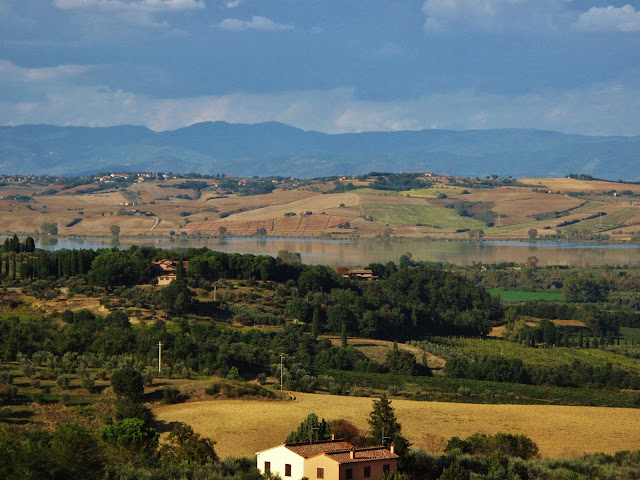
A small Tuscan hill town built on a massive tufa foundation; Chiusi's attractions are all below ground! This charming country village holds a secret under its streets...
For Tuscan adventure seekers, this small somewhat off the beaten path hill town, Chiusi (pronounced choosy) is a troglodyte's dream. At one time, this hilltown was an ancient Etruscan hub and one of the most important cities in Etruria. Building upon a broad tufa rock foundation allowed the Etruscan people to easily dig a network of tunnels used to store wine, collect rainwater or to escape when under attack. The Etruscan name for Chiusi was Clevsin, and it was constructed and settled by pre-Etruscan people dating back to the 8th century BCE. Clevsin was built upon an Etruscan trade route to Rome, later becoming the Via Cassia. The Via Cassia branched off from the Via Flaminia that lead to Umbria, and Clevsin became a Roman town called Clusium.
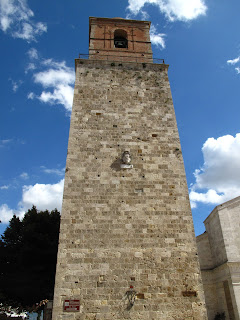
Chiusi is located close to the border of Umbria and Lazio in the south of Tuscany. It is located along the A1 autostrada between Florence and Rome, and many trains stop or change in Chiusi, making it a transportation hub. If you are driving your own car, parking lots near the historic centre are plentiful, and many are free. Try the convenient parking lot off of Via della Pietriccia just behind the town's main square. TIP: If you are planning to see several sights in Chiusi, I would recommend purchasing the Chiusi Museum Card to save on entrance fees. The pass costs €10 and allows admittance to all 3 Chiusi museums.
There is an excellent archeological National Etruscan Museum just off the piazza. There is an extensive collection of Etruscan artifacts and funerary urns. You can also arrange visits to the local Etruscan tombs such as Tomb Of The Pilgram and Tomb Of The Monkey. These tombs are located just outside the town, which requires a guide to tour. The museum entrance fee is €6, and visiting the tombs is €2 and requires advanced reservations.

While this quaint village is pleasant enough to wander around for the day, the real attraction is Chuisi's underground caverns. The Chiusi Civic Museum "The Underground City" on Via II Ciminia offers tours several times a day of the City UNDER the City. Knowledgeable guides take you on a one-hour underground Etruscan city tour of the tunnels, subterranean wells and lakes that were the Etruscan water system network for the large city of the time. Your guide either takes you to the underground lake or the hand-carved well, both were vital water sources to the ancient city with 25,000 residents.
If you don't manage to visit the museum, the Underground City tour has an extensive collection of Etruscan ossuaries. An ossuary is a carved stone box or funerary urn where human remains are placed. The ossuaries were found in the nearby necropolis located out of town. A necropolis is literally a city of the dead where all the ornately carved ossuaries are placed. When someone died, an enormous banquet was held, and many of the ossuaries depicted the dead feasting. The Etruscans used to cremate their dead, but then as Roman culture became popular, inhumation became the fashion.
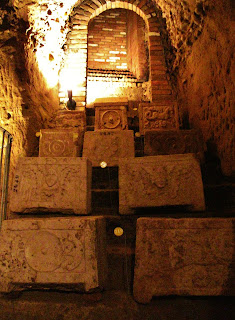
So fascinating! We were shown how to read the Etruscan names on the ossuaries, from right to left. It was interesting that the most popular female Etruscan first name was Tania! Many of the wealthy Etruscans had depictions of themselves carved on top of the ossuary. The departed loved-one appears propped up on one elbow as if eating during a banquet feast, a tradition that the Romans later adopted.
The Greeks, who were at war with the Etruscans and settled in this part of Italy, also had a high impact on the Etruscan culture. The Greek God Dionysus was reflected by the Etruscan wine God named Fuflun, who is depicted on many of the ossuaries.
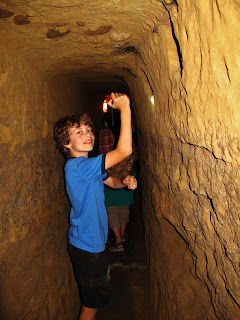
The Cathedral of Chiusi offers another underground tour. The Cathedral of Saint Secondiano or Chiusi's Duomo was built in 560 CE over a Roman Temple, which was converted from an Etruscan Temple. The Duomo's bell tower, which stands separately, was built over a Roman swimming pool that was in use in the first century BCE.
To sign up for this tour, you must go with a registered guide. Buy the tickets at the Duomo museum. The Museum entry fee is €2, the underground tour is €3, a combo ticket is €4. The tour was in Italian, and our guide didn't speak much English, but he was accommodating. We followed the guide outside to access the underground labyrinth through a secret door at the back of the cathedral. Once again we travelled deep underground through a maze of tunnels. If you are claustrophobic, this tour IS NOT the right choice for you. Also, some of the passageways are very narrow, and the robust Italian family that was taking the tour with us had to turn back because one person in their party could not fit through the thin tunnel.

The guide expertly leads you through a literal maze of passageways that were carved out of tuff stone over 2000 years ago. The underground tunnels are dark, cold and eerily quiet. After about 20 minutes, you arrive
at an enormous cistern located directly under the courtyard of the church. This was once a Roman swimming pool. I learned one of my favourite Italian words, "pipistrello," which means bat! There was a colony of bats living in the cistern. A few of them were flying around, disturbed by the flashlights and our voices.

The guided tour ended by having the chance to climb all the way up the bell tower of the church. It must have been hundreds of stairs! Climbing the spiral staircase from the still, dark, cold of the cistern into the bright, searing heat of the afternoon felt like a metaphor of some sort. The views from the belltower are expansive, and one can see all the way to Lake Chiusi nestled amongst the rolling hills.
We definitely earned our gelato today!
I felt the need to find out more about the Etruscan civilization after exploring Chiusi above and under the ground. Maybe a visit to the Etruscan museum in
Cortona is to find out more about these mysterious ancient peoples and their fascinating customs that seemed
to have disappeared into the mists of time.
Chiusi sparks my curiosity about ancient Italian civilizations and beckons me to explore deeper ...underground!

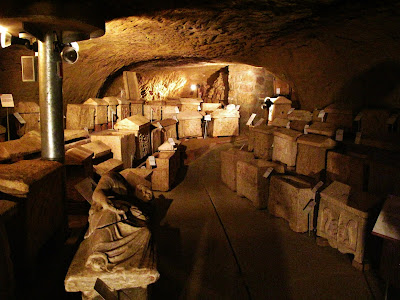

No comments:
Post a Comment